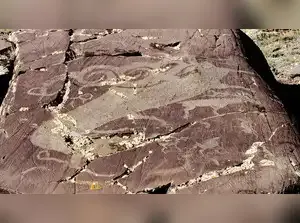The Altai Mountains in Mongolia have ancient rock carvings that tell a story that goes back 12,000 years. This started out as realistic pictures of elk and has turned into abstract, wolf-like symbols.
Elk images in 12,000 years of Altai rock art in western Mongolia have undergone an incredible transformation, according to a recent study by Dr. Esther Jacobson-Tepfer published in the Cambridge Archaeological Journal.
How did elk carvings begin and how realistic were they?
The new study of rock art in western Mongolia shows that elk images have changed over the years, going from realistic carvings to abstract, symbolic figures that look like wolves. This change in art style shows how the climate, mobility, and cultural identity in the Altai region have changed a lot over the years. Over the course of thousands of years, both people and animals evolved at the same time, as quoted in a report by Archaeology Mag.
ALSO READ: Astronomer CEO scandal fallout hits Dublin man with same name - Wife demands flowers after husband mistaken for Andy Byron
From the Late Paleolithic (around 12,000 BP) to the Bronze Age and into the Early Iron Age, the Altai region, which is where Mongolia, Russia, China, and Kazakhstan converge, has one of the longest continuous rock art traditions in the world. Elk (Cervus elaphus sibiricus) carvings were unique among prehistoric carvings, as per a report by Archaeology Mag.
Elk were depicted in their natural settings in the earliest paintings, occasionally alongside their young or alongside other extant creatures like woolly rhinos and mammoths. A profound observational understanding of the natural world was demonstrated by these early representations, which were carved in profile with proportional realism and vestigial legs.
Over time, particularly during the Bronze Age, they underwent significant evolution. Elk grew more active and were incorporated into more and more human activity contexts, like hunting.
The later Bronze Age saw the transition from realism to abstraction, with the elongated elk, exaggerated antlers, and distorted facial details into shapes resembling snouts or beaks. Over time, elk lost much of their resemblance to the actual animal and instead became a symbol, perhaps of spirituality, clan identity, or status.
It would be impossible for painted images to survive outdoors in the Altai Mountains due to the climate and the significant amount of time that has passed since the Bronze and Early Iron Ages. The only known surviving painted elk image is located in Khoit Tsenkir cave in Khovd Aimag.
Social and environmental change seem to be closely linked to this symbolic development. Forests, which were desirable habitats for elk, receded as the Eurasian steppe cooled and dried during the Holocene.
As elk moved west, the changing terrain led to a rise in the number of people practicing pastoralism. As carvings emerge at higher elevations over time, rock art itself bears witness to this change.
Dr. Jacobson-Tepfer's extensive fieldwork experience in the area highlights the impact of climate and movement on everyday life and art.
She discovered a huge glacial boulder that overlooked a wide valley floor in 1995 while surveying Tsagaan Salaa IV. Among hundreds of them, one distorted, unearthly image of an elk was carved on its surface.
She described the boulder as more than just an artifact; it was a symbol of changing cultural identity, writing, "It seemed to reflect a complex interweaving of deep geological time, iconography, and its social implications."
Eventually, horseback riding altered how people interacted with the outside world. Symbolizing new social hierarchies and mobility, art featured stylized animals on personal items.
Once a living component of the natural world, the elk has evolved into a symbolic animal. It vanished entirely from the tradition of art by the time of the Turks.
The shift reflects environmental change, increased pastoralism, and a changing cultural identity.
What do the abstract elk images depict?
More likely to be symbols of status, clan identity, or spiritual belief than actual animals.
Elk images in 12,000 years of Altai rock art in western Mongolia have undergone an incredible transformation, according to a recent study by Dr. Esther Jacobson-Tepfer published in the Cambridge Archaeological Journal.
How did elk carvings begin and how realistic were they?
The new study of rock art in western Mongolia shows that elk images have changed over the years, going from realistic carvings to abstract, symbolic figures that look like wolves. This change in art style shows how the climate, mobility, and cultural identity in the Altai region have changed a lot over the years. Over the course of thousands of years, both people and animals evolved at the same time, as quoted in a report by Archaeology Mag.
ALSO READ: Astronomer CEO scandal fallout hits Dublin man with same name - Wife demands flowers after husband mistaken for Andy Byron
From the Late Paleolithic (around 12,000 BP) to the Bronze Age and into the Early Iron Age, the Altai region, which is where Mongolia, Russia, China, and Kazakhstan converge, has one of the longest continuous rock art traditions in the world. Elk (Cervus elaphus sibiricus) carvings were unique among prehistoric carvings, as per a report by Archaeology Mag.
Elk were depicted in their natural settings in the earliest paintings, occasionally alongside their young or alongside other extant creatures like woolly rhinos and mammoths. A profound observational understanding of the natural world was demonstrated by these early representations, which were carved in profile with proportional realism and vestigial legs.
When did elk art become abstract and why?
Over time, particularly during the Bronze Age, they underwent significant evolution. Elk grew more active and were incorporated into more and more human activity contexts, like hunting.
The later Bronze Age saw the transition from realism to abstraction, with the elongated elk, exaggerated antlers, and distorted facial details into shapes resembling snouts or beaks. Over time, elk lost much of their resemblance to the actual animal and instead became a symbol, perhaps of spirituality, clan identity, or status.
It would be impossible for painted images to survive outdoors in the Altai Mountains due to the climate and the significant amount of time that has passed since the Bronze and Early Iron Ages. The only known surviving painted elk image is located in Khoit Tsenkir cave in Khovd Aimag.
What does this change say about ancient Mongolian life?
Social and environmental change seem to be closely linked to this symbolic development. Forests, which were desirable habitats for elk, receded as the Eurasian steppe cooled and dried during the Holocene.
As elk moved west, the changing terrain led to a rise in the number of people practicing pastoralism. As carvings emerge at higher elevations over time, rock art itself bears witness to this change.
Dr. Jacobson-Tepfer's extensive fieldwork experience in the area highlights the impact of climate and movement on everyday life and art.
She discovered a huge glacial boulder that overlooked a wide valley floor in 1995 while surveying Tsagaan Salaa IV. Among hundreds of them, one distorted, unearthly image of an elk was carved on its surface.
She described the boulder as more than just an artifact; it was a symbol of changing cultural identity, writing, "It seemed to reflect a complex interweaving of deep geological time, iconography, and its social implications."
Eventually, horseback riding altered how people interacted with the outside world. Symbolizing new social hierarchies and mobility, art featured stylized animals on personal items.
Once a living component of the natural world, the elk has evolved into a symbolic animal. It vanished entirely from the tradition of art by the time of the Turks.
FAQs
Why did ancient elk carvings change so dramatically over time?The shift reflects environmental change, increased pastoralism, and a changing cultural identity.
What do the abstract elk images depict?
More likely to be symbols of status, clan identity, or spiritual belief than actual animals.








